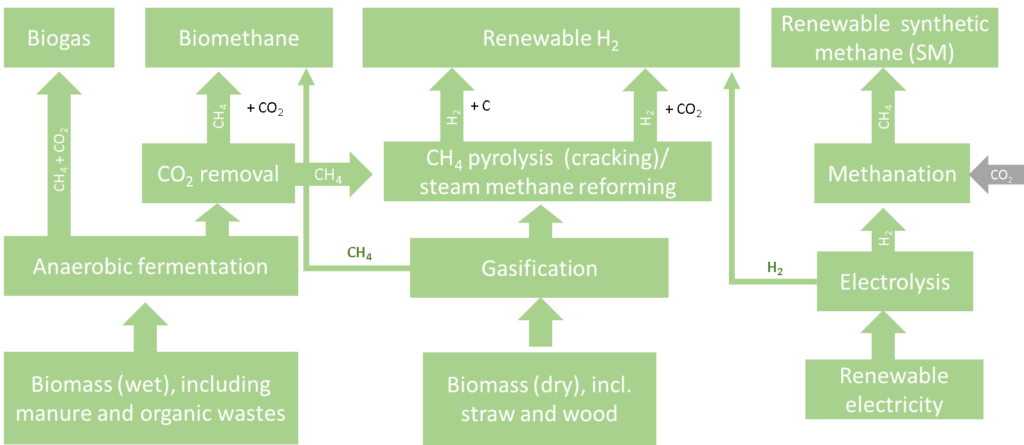Renewable Gases – Hydrogen in the Grid
Renewable gases, including hydrogen (H2), will be a key component of the global energy system aiming at net zero greenhouse gas (GHG) emissions by 2050. Net Zero Emissions scenario for 2050 shows that under a strict GHG mitigation logic, fossil gas supply will be peaking in the mid-2020s and shrinking up to 2050. In parallel, renewable gases (biomethane, H2, H2-based synthetic methane) will have to strongly increase to displace fossil gas.
This report provides a synthesis of an IEA Bioenergy project on renewable gases (RG) and the effect of hydrogen in gas grids. The activity was funded by the European Commission, Germany, and Sweden, with contributions from the Netherlands. The project collected existing data, performance indicators, information on RG studies & projects and analysed national strategies. It also identified and discussed the numerous challenges and hurdles for the gradual replacement of natural gas by renewable gases, with emphasis on H2 addition to the natural gas grid, and dedicated H2 grids.
Overall take-away: biomethane and renewable synthetic methane can already be carried by the existing gas network infrastructure without any problems, and injection of a limited amount of renewable hydrogen (H2) in the gas grid is also feasible. The injection of larger quantities of H2 and the transition to 100% H2 will require step-by-step technical modifications or further development of the gas distribution networks and the customer facilities connected to them.
Full report: Renewable Gases – H2 in the grid

Figure: Simplified overview of renewable gases production pathways
The study analysed the role of renewable gases in national policies for GHG emission reductions by 2030-2050 and respective estimates for the amounts needed by 2030-2050, with a focus on H2 strategies and roadmaps.
Most country strategies and roadmaps see H2 as a means to overcome the limits of electrification and to help stabilize electricity grids against a growing share of variable renewable generation, especially solar and wind. Some H2 strategies address the potential role of longer-term energy storage needs to bridge seasonal variations in renewable electricity generation. Several countries indicate their ambition to export H2 in the 2030 timeframe and after, while others assume H2 imports. Besides trade, most strategies focus on domestic H2 application in hard-to-abate sectors, i.e., those where GHG emission reduction by renewable electrification is hindered, e.g., the chemical industry, steel making, and transport (aviation, long-haul road, shipping), in some cases as H2-based synthetic fuels. Nearly all country strategies and roadmaps address the role of existing gas infrastructure for future H2 transmission and distribution and see H2 clusters as an important step towards H2 use, both in industry, and in regional H2 networks.
Biomethane and synthetic methane (SM) can already be added to the existing gas infrastructure without problems. Co-processing biogas and H2 to biomethane/synthetic methane in hybrid plants could boost near-term grid-compatible production. Next to that, direct H2 injection in gas grids (HIGG) could provide a steppingstone for developing a H2 infrastructure with adding up to 20 vol% of H2 to the gas grid, i.e. about 7 % by energy content. For higher H2 shares in the gas grid without compromising downstream distribution and end-uses, the gas transmission system could be used for H2 transport only (in blended form with with natural gas) and H2 could be separated from transported natural gas before it is distributed to end-users. H2 separation would add $2 – $4 per kg of H2 in the longer-term.
A potential alternative to HIGG (and later separation) is to convert H2 into renewable synthetic methane (SM) to make it fully compatible with existing natural gas infrastructure and end-use technologies. Methanation of H2 (biological or catalytic conversion of H2 and CO2 to methane) costs about 50% less than the longer-term additional cost of H2 separation and could help balancing the electricity system and longer-term storage of renewable electricity.
Converting existing natural gas transmission pipelines to H2 (“repurposing”) is possible in many cases. Cost of doing so would add approx. 0.05 $/kg H2 (depending on the lifetime and throughput of the grid), while cost for new dedicated H2 pipelines are twice as high. Costs to convert the gas distribution to be fully H2-compatible are about 20 % of repurposing transmission pipelines, and approx. 1/3 of new dedicated H2 pipelines, but strongly depend on the geographical distribution of end-users, and the topography of the area served.
There is a clear transition logic from natural to renewable gas which also helps integration with the (decarbonized) electricity system.
Yet, there are many hurdles and obstacles in the regulatory system: As H2 in the grid is a rather new issue, the transformation of the gas system and “coupling” with other energy sectors is quite complex, and the international dimension of trade, especially when including climate policies, is challenging.
Fundamental legal and administrative barriers which hinder H2 injection into gas grids concern legal complexity or absence of permitting rules, divergent regulation on H2 concentration levels in gas grids, contracts and billing arrangements based on calorific value or Wobbe Index, safety requirements for connection/injection of H2, and for all types of end-user equipment.
Among the regulatory issues, the color and origin of H2 and respective GHG emission thresholds, the additionality requirements for green H2, access for H2 producers to the gas grid and respective grid development planning are, together with H2 safety issues, the most relevant topics which need to be addressed.
Open questions on “H2 in the grid” remain for which further research should be carried out:
- Is H2 more favourable that direct electricity use in the (non-industrial) heat and road transport sectors?
- What is the longer-term perspective of H2 vs. renewable synthetic methane, considering economic benefits for electricity system services and the economic value of existing gas infrastructure?


